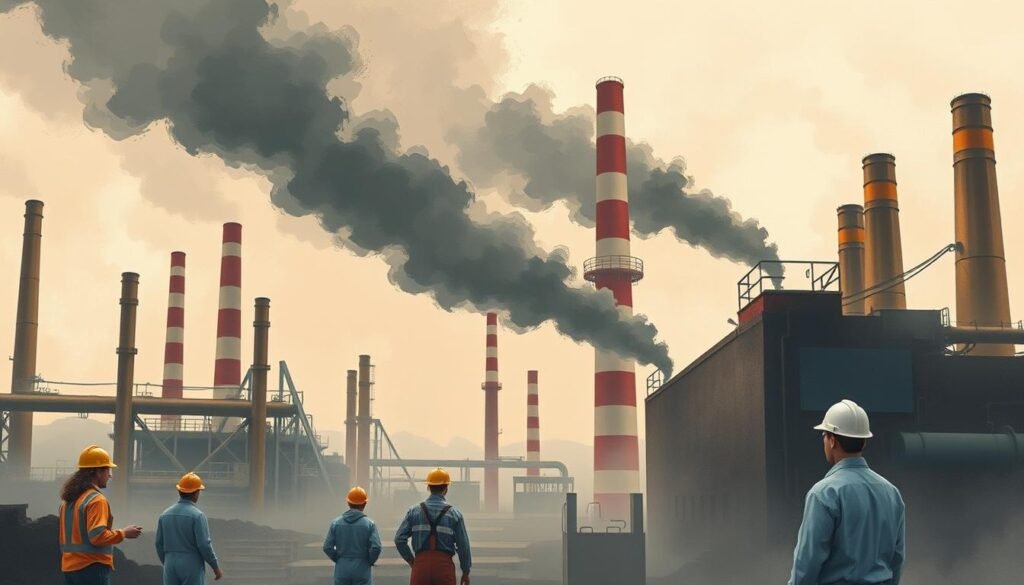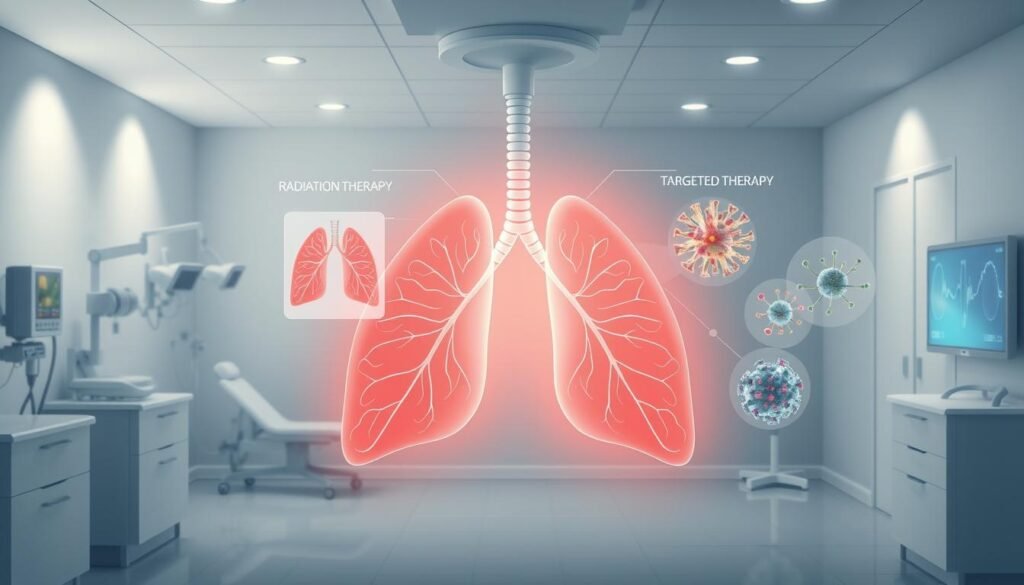Did you know smokers with at least 20 pack years face a higher lung cancer risk? A study with 4,279 people averaging 72.8 years old showed this clearly. It looked at how smoking affects the chances of getting lung cancer.
While just 0.5% of people who never smoked got lung cancer, the rate soared for smokers. This insight is crucial for understanding how smoking impacts lung cancer risks.
This article examines the link between smoking a lot over time and lung cancer risk. It’s about people who have smoked for 20 pack years. Knowing this can help make better screening rules and improve health for those at risk. With a push for stopping smoking, it’s clear we need tailored screenings to really prevent lung cancer.
Key Takeaways
- The risk of lung cancer increases significantly with a history of 20 pack years of smoking.
- Only 0.5% of never smokers in the study developed lung cancer, compared to 5% of current smokers with less than 20 pack years.
- Long-term smoking cessation can reduce lung cancer risk but does not eliminate it entirely.
- Screening guidelines may need to adapt to include lower pack year thresholds to catch more cases early.
- Approximately 10 million individuals in the U.S. are currently eligible for lung cancer screening.
- Minorities and women are disproportionately affected by the current screening eligibility criteria.
Understanding Lung Cancer Risk Factors
Lung cancer risk factors include many elements that boost the risk of this disease. They focus on the environmental and genetic influences. Lifestyle choices and environmental exposures are the main causes of lung cancer. It’s vital to know these factors to prevent the disease effectively.
Primary Causes of Lung Cancer
Smoking is the top cause of lung cancer, leading to 80% of deaths. It covers different tobacco products and marijuana smoke. Marijuana smoke has tar and carcinogens. Radon, a natural gas found indoors, is the second main cause in the U.S. Asbestos and previous lung radiation therapy also increase the risk, especially for smokers.
The Role of Smoking in Lung Cancer Epidemiology
Smoking is a major factor in lung cancer, linked to about 85% of cases. Yet, 15-20% of men and over 50% of women with lung cancer are non-smokers. These cases show that risk factors for lung cancer vary greatly. Non-smokers may have different genetic predispositions or environmental exposures. Understanding smoking’s impact helps in crafting public health strategies to lower lung cancer rates.
Defining Pack-Years: What It Means
Pack-years are an important way to measure smoking exposure. They help us understand lung cancer risks better. A pack-year means the amount of cigarette packs smoked daily times the years someone has smoked. This calculation is crucial for studying lung cancer risk.
How to Calculate Pack-Years
It’s easy to figure out pack-years. Here’s the formula:
Pack-Years (PY) = Number of Packs per Day (N) x Number of Years Smoked (T)
Let’s look at some examples:
| Smoking History | Packs per Day (N) | Years Smoked (T) | Pack-Years (PY) |
|---|---|---|---|
| 1 pack/day for 20 years | 1 | 20 | 20 |
| 2 packs/day for 30 years | 2 | 30 | 60 |
| Half a pack/day for 30 years | 0.5 | 30 | 15 |
This calculation lets healthcare providers grasp pack-years’ role in lung cancer research.
Importance of Pack-Years in Lung Cancer Studies
Pack-years are vital in lung cancer research. They give a clear way to see an individual’s lung cancer risk based on smoking. Studies show that people who smoke more than 15 pack-years are at a higher risk. For instance, 70% of stage IIIB/IV Non-Small Cell Lung Cancer patients had over 15 pack-years of smoking.
Knowing about pack-years helps examine lung cancer trends among different people. It improves public health efforts to fight smoking-related diseases. This measurement is also valuable in looking at past data, like the Framingham Heart Study. It helps us better understand patient histories.
Comparison of lung cancer risk between those with 20 pack years and non-smokers
Looking at the comparison of lung cancer risk between people with 20 pack years and those who never smoked shows important findings. Studies show that heavy smokers are more likely to get lung cancer than non-smokers. This highlights the need to better screen people who used to smoke a lot.
Statistical Analysis of Lung Cancer Incidence
Statistics reveal that having a 20 pack year smoking history greatly increases lung cancer risk. Heavy smokers face a risk more than ten times that of non-smokers, even if they’ve stopped. This shows why it’s crucial to make screening guidelines more inclusive, particularly for different racial groups.
Long-Term Risks Associated with Former Smokers
Quitting smoking doesn’t immediately remove the risk of lung cancer for former smokers. Those with 20 pack years of smoking history still face health challenges compared to non-smokers. The research findings emphasize the need for more focused lung cancer screening efforts across various communities.
The Impact of Smoking Cessation on Lung Cancer Risk
Quitting smoking is key to lowering lung cancer risk. Studies show that lung cancer risk drops greatly within the first five years after quitting. This means the chance of getting this disease goes down a lot once people stop smoking. About 85% of lung cancers come from smoking. This shows how important it is to quit smoking for good health.
Reduction in Risk After Quitting Smoking
People who stop smoking greatly reduce their risk of lung cancer. Statistics reveal a 39.1% drop in risk in just five years for those who quit. Additionally, high-risk individuals see a 20% decrease in lung cancer deaths when screened. Yet, former smokers still face a higher risk than those who’ve never smoked. Even after 25 years without smoking, their risk is still three times higher.
Challenges Faced by Long-Term Former Smokers
Long-term former smokers face big challenges with lung cancer risk. Some may not qualify for lung cancer screening because of their past smoking and how long they’ve quit. Research shows that 58.7% of those diagnosed with lung cancer through screening weren’t initially eligible. With over 55.2 million former smokers in the U.S., it’s critical to keep focusing on these risks.

For detailed info on how stopping or reducing smoking reduces lung cancer risk in COPD patients, check out this study. Learn more about the findings here.
Secondhand Smoke Exposure and Its Effects
Secondhand smoke exposure is a big public health challenge. It greatly adds to lung cancer rates. Many studies show a clear link between secondhand smoke and lung cancer, emphasizing the need for strong health actions. It’s crucial to look into how secondhand smoke affects smokers and non-smokers.
Statistics on Secondhand Smoke and Lung Cancer
Studies share startling facts about secondhand smoke and lung cancer. Each year, secondhand smoke causes over 7,300 lung cancer deaths in the U.S. The risk of lung cancer increases for those exposed to secondhand smoke; it’s shown by the overall relative risk of 1.24. This risk gets even higher based on where and how long someone is exposed:
| Setting | Relative Risk (95% CI) |
|---|---|
| Home | 1.20 (1.12–1.28) |
| Workplace | 1.38 (1.28–1.62) |
| Home or Workplace | 1.37 (1.22–1.53) |
| Non-specified Settings | 1.27 (1.11–1.44) |
Non-smokers with secondhand smoke exposure have a 24% higher lung cancer risk. The data shows that more exposure leads to higher lung cancer risk.
Public Health Implications
The public health effects of secondhand smoke exposure are huge. With many lung cancer cases linked to it, there’s a big push for policies to reduce exposure. Smoking bans and awareness efforts are key to fighting the effects of secondhand smoke. These steps are vital to protect people and reduce lung cancer’s toll on society.
Genetic Susceptibility to Lung Cancer
Learning about genetic factors is key to understanding lung cancer. Many genetic elements increase the risk, especially with smoking. Certain genes make people more vulnerable to lung cancer when they’re exposed to things like smoking. This highlights the connection between our genes and our choices.
How Genetics Influence Cancer Risk
Genetics play a big role in lung cancer risk. People with certain genetic profiles are more likely to get lung cancer, especially smokers. The Framingham Heart Study shows that smoking adds to the risk in a big way. Yet, those who have never smoked but have risky genes also face a high risk.
Current Research in Genetic Risk Factors
Scientists are making progress in finding specific genes linked to lung cancer. They’ve noticed how smoking affects those with genetic risk differently. They’re learning how smoking changes genes in smokers and non-smokers. This could help with better prevention and early detection. It shows why it’s important to consider genetics in lung cancer risks.
The Effects of Air Pollution on Lung Cancer Risk
Air pollution is a big risk factor for lung cancer, impacting public health. Sources like vehicle emissions, industrial discharge, and household contaminants contribute to this risk. It’s crucial to understand these sources because they play a key role in raising lung cancer risk globally.
Sources of Air Pollution and Their Impact
Primary sources of air pollution include:
- Vehicle emissions leading to high levels of nitrogen oxides and particulate matter.
- Industrial activities releasing carcinogens like polycyclic aromatic hydrocarbons.
- Use of solid fuels for cooking, notably in low- and middle-income countries (LMICs).
- Household air pollution from burning coal and improper ventilation.
Studies show these factors make people more vulnerable to lung cancer. For instance, household air pollution was linked to 21.7% of lung cancer deaths in males and 29.9% in females. When combined with smoking, the risk of lung cancer goes up even more.
Case Studies Linking Air Quality and Lung Cancer
Many case studies show a clear link between bad air quality and higher lung cancer risk. One study in China followed 323,794 nonsmokers over 10.2 years. It found 979 deaths from lung cancer. This study showed lung cancer deaths increased by 4% for every five-year period of exposure. Moreover, cooking in poorly ventilated areas made lung cancer risk 69% higher for those using coal.
These studies highlight the need for better rules to reduce air pollution. Lung cancer cases have gone up by 37% from 2007 to 2017. This highlights how important it is to tackle environmental factors related to lung cancer. Making detailed prevention policies could greatly reduce early deaths from diseases like lung cancer.
Occupational Hazards and Lung Cancer Risk
Many workers in industries such as construction, manufacturing, and mining face a big risk of lung cancer. This is because they are often exposed to dangerous materials like asbestos and silica. Knowing which industries are most at risk helps us protect workers better.
Industries with Higher Lung Cancer Rates
Some jobs have much higher lung cancer rates due to harmful exposure. Here are a few high-risk industries:
| Industry | Exposure Risks | Relative Lung Cancer Risk |
|---|---|---|
| Construction | Asbestos, silica dust | 2.17 |
| Manufacturing | Asbestos, benzene | Risk increases with years of exposure |
| Mining | Coal dust, silica | Higher risk for long-term workers |
| Textile | Chemicals, dust | Increased risk linked to work duration |
Prevention Strategies for At-Risk Workers
To lower lung cancer risks at work, we must take serious steps. Here are some ways to help:
- Regular health screenings: Finding lung problems early can lead to better health outcomes.
- Use of protective equipment: Wearing masks and ventilators can cut down on harmful exposure.
- Workplace education: Teaching employees about their job risks makes the workplace safer for everyone.
- Monitoring air quality: Checking the air regularly helps spot dangers early on.
- Strict safety regulations: Laws that focus on keeping workplaces safe are crucial for cutting down on risks.

Lung Cancer Screening Guidelines and Recommendations
Screening for lung cancer is key in saving lives. It’s vital for smokers, especially those who have smoked a lot over the years. For people between 50 and 80 who have smoked heavily, getting a low-dose CT scan is recommended. This helps find lung cancer early, making treatment more effective. Knowing the latest screening guidelines is crucial for smokers. It helps understand the benefits of regular check-ups.
Current Guidelines for Smoking Populations
There are specific guidelines for people at high risk due to smoking a lot. Here are the main points:
- Men and women aged 50-80 who have smoked a pack a day for 20 years should get screened every year.
- If you stopped smoking in the last 15 years, you might still need to get screened regularly.
- If lung cancer runs in your family, talk to your doctor about getting screened.
Importance of Screening for Early Detection
Finding lung cancer early is crucial. It can greatly increase the chances of survival. Here’s what screening shows:
- If lung cancer is found early, the five-year survival rate is 60%. This drops to 6% for advanced cases.
- Regular screening can spot non-small cell lung cancer (NSCLC), which is easier to treat than small cell lung cancer (SCLC).
Following the screening rules for smokers leads to better health. Staying aware and taking action against lung cancer is a life-saver.
| Age Group | Smoking History | Screening Recommendation |
|---|---|---|
| 50-80 | 20+ pack-years | Annual low-dose CT scans |
| 50-80 | Former smoker (quitted within 15 years) | Consider annual low-dose CT scans |
| All ages | Family history of lung cancer | Consult healthcare provider |
Treatment Options for Lung Cancer Patients
Lung cancer has many treatment options. These reflect the disease’s complexity and patient needs. Traditional treatments like surgery, chemotherapy, and radiation have been main. Yet, new therapies are changing these methods. The aim is to improve patient outcomes.
Overview of Traditional Treatments
Surgery is key for some lung cancer cases, especially non-small cell types. It might involve removing the tumor and some healthy tissue. Sometimes, part of the lung is also removed. This helps prevent cancer from coming back.
Radiation therapy uses high-energy beams to destroy cancer cells. It can help relieve symptoms or support surgery. Chemotherapy involves using drugs to target cancer cells. It may shrink tumors before surgery or attack leftover cancer cells afterward. Side effects like fatigue and hair loss need careful management.
Emerging Therapies and Research Innovations
New lung cancer treatments are showing promise. Targeted therapies attack specific genetic changes in cancer cells. Immunotherapy boosts the immune system to fight cancer, especially hidden cells. These advances represent a shift in how we treat lung cancer.
Research now aims to customize treatment for each patient. This includes looking at genetics and how a patient might respond to therapy. It’s a hope-filled direction for lung cancer care, aiming at better survival rates. Early diagnosis remains critical for success.
As treatments evolve, information is vital for both doctors and patients. Keeping up with the latest in lung cancer is key. For those interested in lung cancer’s specifics, especially in non-smokers, here’s a valuable resource.

Epidemiological Studies: Findings and Implications
Epidemiological studies show how smoking links to lung cancer. They analyzed a large dataset with 13,169 lung cancer cases and 16,010 controls. These studies found key patterns across different groups, focusing on smokers.
Key Studies on Smoking and Lung Cancer
Research shows adenocarcinoma (AdCa) is most common in non-smoking women, while squamous cell carcinoma (SqCC) is more in male smokers. Men smoking over 30 cigarettes daily had an odds ratio (OR) of 103.5 for SqCC. This highlights smoking’s strong link to cancer. Women with high smoking rates also saw a significant OR of 62.7 for SqCC.
Variations in Findings Across Different Demographics
The studies also highlight differences among groups. For example, women smokers face a greater risk for lung cancer. They showed an OR of 16.8 for AdCa. These findings highlight the importance of considering a person’s smoking history and background.
They suggest that strategies to combat lung cancer need to address these different risks. Understanding how smoking affects various groups helps in fighting lung cancer more effectively.
The connection between allergies, inflammation, immune response, and cancer is crucial. Certain allergies may impact lung health. This highlights the importance of more studies for better prevention. For extra details, visit this link.
| Gender | Most Prevalent Subtype | OR for SqCC (≥30 cigarettes/day) | OR for AdCa (≥30 cigarettes/day) |
|---|---|---|---|
| Men | SqCC | 103.5 | 21.9 |
| Women | AdCa | 62.7 | 16.8 |
| Never Smokers (overall) | AdCa | N/A | N/A |
| Ever Smokers (males) | SqCC | N/A | N/A |
| Ever Smokers (females) | AdCa | N/A | N/A |
Conclusion
Looking at lung cancer risks, there’s a big difference between smokers and non-smokers. Smokers, especially those with a 20 to 29 pack-year history, have higher risks. This highlights the importance of focusing on helping people quit smoking. Also, it shows why we need better screening for those at high risk.
Quitting smoking can greatly lower the risk of lung cancer. People who stop smoking can see their risk decrease by up to 75% after ten years. This info is crucial for guiding future research. It helps us understand more about lung cancer among both former smokers and people who never smoked.
It’s also key to look at who gets lung cancer more, like women and minority groups. This understanding can help shape better health policies and interventions. Having more info can lead to better ways to prevent lung cancer in these groups. For more details, check this study.